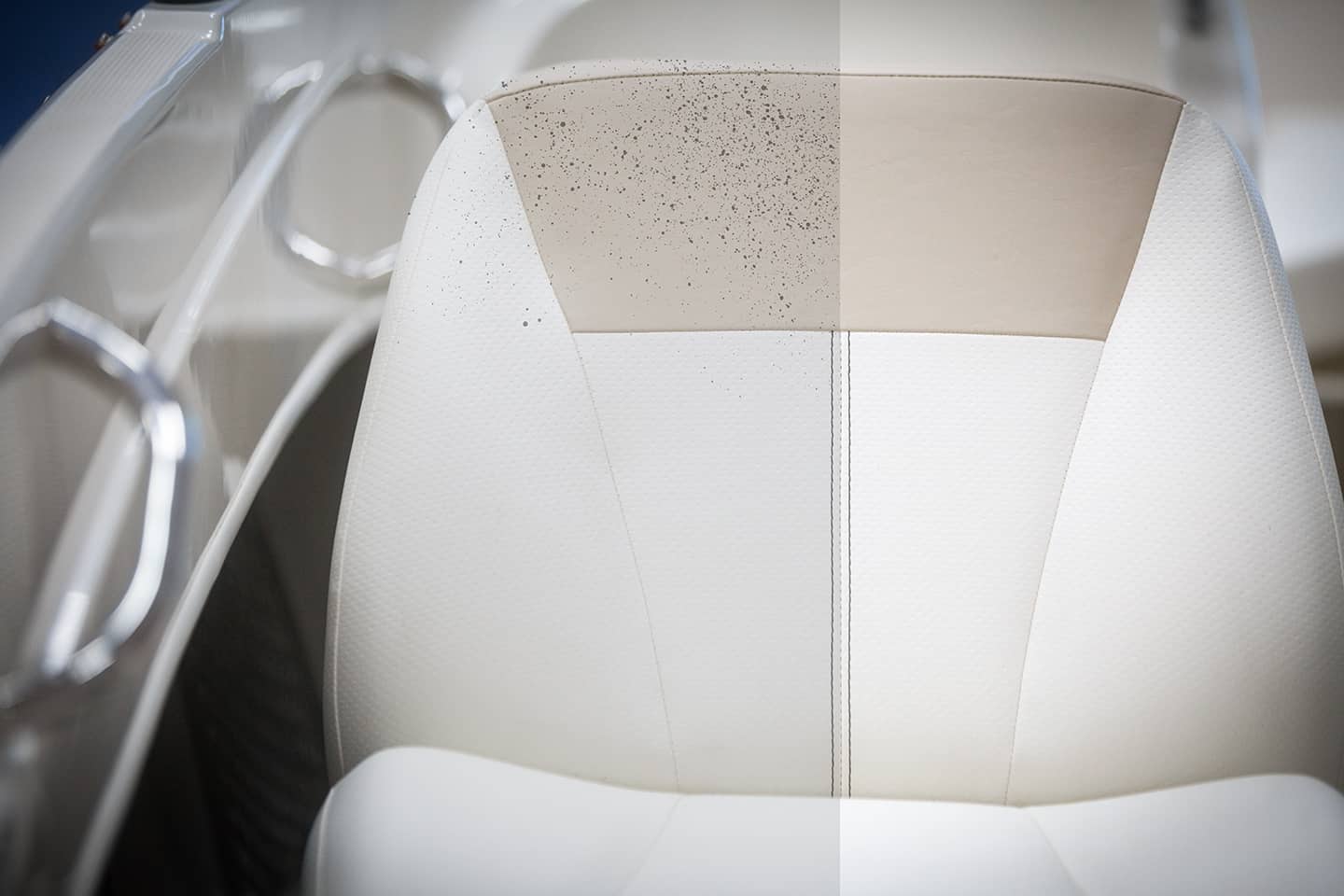How to Clean Boat Seats

UV rays, sweat, sunscreen, and the build-up of grime can all wreak havoc on your seat cushions and marine upholstery over time. In this article, we will outline how to clean boat seats with preventative and corrective cleaning techniques.
Regular cleaning of marine vinyl enhances the look and resale value of your boat and your boating experience. Keeping your boat clean and dry also prevents dampness that can cause mildew stains to develop on your vinyl.
Luckily, cleaning boat seats is a fairly simple task if you keep up on it regularly and follow a few simple steps to keep your seats dry.
Boat Seat Cleaning Tips
- Make sure the surface is clear of any loose debris before you start
- Work in the coolest, dryest place you can (you don’t want the sun immediately drying products you spray on the vinyl)
- Make sure to have clean cloths, clean towels, and clean water
- Avoid the use of bristle brushes (even soft brushes) on your boat seats (this can damage the fibers)
- Never leave damp towels in your boat
Preventative Boat Seat Cleaning
When it comes to keeping boat seats clean, the best defense is a good offense. Simply wiping down the seats after use and keeping them dry is often enough to stop mildew in its tracks. Below are methods to clean vinyl boat seats:
- Cleaning Vinyl Boat Seats with Household Cleaners
- Cleaning Vinyl Boat Seats with Vinyl Cleaners
- Vinyl Protectant
- Boat Seat Covers and Boat Covers
Cleaning Vinyl Boat Seats with Household Cleaners
Frequency: Every time you use the boat
You can easily keep boat seats cleans with one simple household cleaner. All you need is a few drops of dish soap into a spray bottle filled with water and you are good to go. I keep a small bottle of this solution right on my boat with a clean cloth for a quick wipe down after every trip onto the water.
Give the seats a gentle spray with the dish liquid and water solution, wipe with a clean cloth, then dry the seats with a high-absorbency towel. It is the presence of water and dampness that causes mildew, so improper drying after cleaning can cause more harm than good.
If you do have a few scruffs that do not come off easily, a household magic eraser does a good job at removing those with ease. Some brands of magic erasers contain harsh chemicals that can damage vinyl boat seats, so use sparingly, or look for a Boat Eraser that does not include ingredients like bleach.
The use of bleach in any form can be very damaging to your boat. Never clean your boat seats or boat with bleach.
Cleaning Vinyl Boat Seats with Vinyl Cleaner
Frequency: 3-4 Times Per Year (or as needed)
There are also many dedicated marine vinyl cleaners on the market. With these products, you can be sure that they don’t contain anything that will damage the vinyl, which helps to take the guesswork out of selecting the right product.
Brands like Star brite, Boat Juice, Meguiar’s, and 3M all have vinyl cleaning products that are clearly labeled as “marine” friendly. These types of vinyl cleaners also have the added bonus of having some conditioning properties and leave a subtle sheen behind.
The use instructions for almost all vinyl boat seat cleaners are fairly similar. Simply spray one, then wipe with a clean cloth using a circular motion, and buff off any remaining product with a clean towel until dry.
Vinyl Protectant
Frequency: 2-3 Times Per Year (or as needed)
Vinyl protectants are often included in vinyl cleaners, but you can also opt for a dedicated vinyl protectant. Vinyl protectants are like sunscreen for your boat seats. They provide necessary UV protection and work as a conditioner for your marine upholstery.
Just like sunscreen, these UV protectants also help prevent fading and cracking over time, repel dust, lint, and staining, and assist in restoring lost color and luster.
You don’t need to use a vinyl protectant every time to clean your seats. At regular use, 2-3 times per year is often enough. Keep in mind that this greatly depends on how often you use your boat, how hard you (and your kids) are on the seats, and your climate.
I recommend just giving the seats a feel check from time to time. Just like skin, you can sense when marine vinyl is getting dry. If you detect this, it’s time to break out the protectant.
Boat Seat Covers and Boat Covers
Boat Seat Covers and Boat Covers are not exactly a cleaning technique, but they are worth mentioning here because they help keep your boat seats dry and thus mildew-free. The recipe for mildew is pretty simple:
Moisture + Humidity = Mildew
You want to stop moisture from sitting on your seats in any capacity, whether that’s by drying the seats with a towel, or covering the seats with either boat seat covers or a boat cover. If you are storing your boat outside, a cover in some capacity will be necessary to keep dew and rain off the seats.
For boaters that leave their boat docked, simple seat covers can be a little quicker to pop on and off between boat rides. If you are trailering your boat, you are probably already putting your cover on.
Corrective Boat Seat Cleaning
If mildew happens, you need to switch into corrective mode and this requires some more dedicated products to get the job done.
Mildew stains are a fairly common problem, and particularly obvious when you have white vinyl boat seats. If you have spent any time on a pontoon, you have probably seen this issue rear its ugly head.
What do Mildew Stains Look Like?

The first thing you need to do is ascertain if what you are dealing with is mildew stains. Mildew stains on marine-grade vinyl often take the form of clusters of black and grey spots that look like embedded dirt.
You will usually see this form on typical wear areas like backrests and the edges of swivel chairs where people tend to put their hands.
If you think this is what you have, start with a regular vinyl cleaner and if that doesn’t get rid of the problem, move up to a mildew stain remover.
How to Remove Mildew Stains from Boat Seats
If you have mildew, you will need a mildew stain remover. Mildew stain removers have the correct active ingredients to wipe out the mildew issue.
Make sure to select one that is rated for marine vinyl use. You will see it contain a mix of ingredients like stain removers, buffered bleach, surfactants, and degreasing agents.
Wait! I know, I know. I told you not to use bleach at the beginning (glad to see you are paying attention). Without getting into the chemistry, buffered bleach is more effective than bleach water and also will not damage the material or threads.
The application method is really simple with these products, just spray on, scrub lightly and rinse off stains. Don’t be alarmed though if one treatment is not enough. You may need to go through this process a few times to fully remove the stains.
Let the vinyl completely dry between each application so you can properly access where you are at.
If the stains continue to persist, you may need to bring in a pro and hire a local upholstery cleaning shop to give you a hand.
Bottom Line
Keep your boat seats as clean and dry as you can on a regular basis and they will stay in great condition for years. Having said that, the point of a boat is to be fun, and s!*t might happen. You are going to get caught in the rain without a cover, wet towels are going all over the place, and sunscreen-filled hands are going to touch your upholstery.
Just stay on it and do a regular enough damage report so you know when to bring in the right product for the job.
You will also want to give cleaning love to the whole boat and not just the seats. Check out our articles on How to Clean a Boat for information on how to clean the exterior and full interior of your vessel.

About Deb Sauvé
This article may contain affiliate links which I earn a commision through when you purchase. As an Amazon Associate I earn from qualifying purchases.
Please read why I do this and my commitment to accurate and compelling content.

